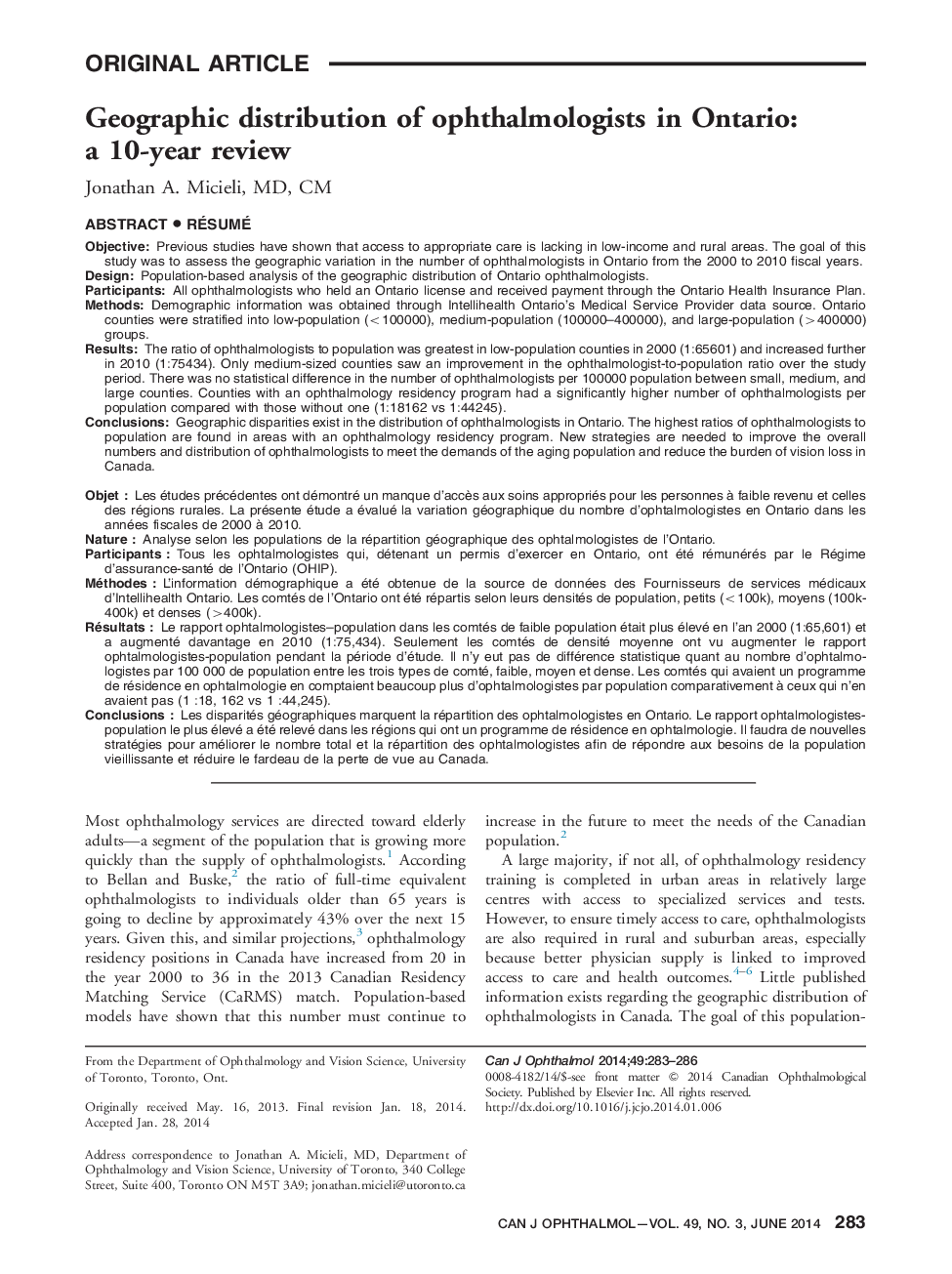| کد مقاله | کد نشریه | سال انتشار | مقاله انگلیسی | نسخه تمام متن |
|---|---|---|---|---|
| 4009393 | 1602403 | 2014 | 4 صفحه PDF | دانلود رایگان |
ObjectivePrevious studies have shown that access to appropriate care is lacking in low-income and rural areas. The goal of this study was to assess the geographic variation in the number of ophthalmologists in Ontario from the 2000 to 2010 fiscal years.DesignPopulation-based analysis of the geographic distribution of Ontario ophthalmologists.ParticipantsAll ophthalmologists who held an Ontario license and received payment through the Ontario Health Insurance Plan.MethodsDemographic information was obtained through Intellihealth Ontario’s Medical Service Provider data source. Ontario counties were stratified into low-population (<100000), medium-population (100000–400000), and large-population (>400000) groups.ResultsThe ratio of ophthalmologists to population was greatest in low-population counties in 2000 (1:65601) and increased further in 2010 (1:75434). Only medium-sized counties saw an improvement in the ophthalmologist-to-population ratio over the study period. There was no statistical difference in the number of ophthalmologists per 100000 population between small, medium, and large counties. Counties with an ophthalmology residency program had a significantly higher number of ophthalmologists per population compared with those without one (1:18162 vs 1:44245).ConclusionsGeographic disparities exist in the distribution of ophthalmologists in Ontario. The highest ratios of ophthalmologists to population are found in areas with an ophthalmology residency program. New strategies are needed to improve the overall numbers and distribution of ophthalmologists to meet the demands of the aging population and reduce the burden of vision loss in Canada.
RésuméObjetLes études précédentes ont démontré un manque d’accès aux soins appropriés pour les personnes à faible revenu et celles des régions rurales. La présente étude a évalué la variation géographique du nombre d’ophtalmologistes en Ontario dans les années fiscales de 2000 à 2010.NatureAnalyse selon les populations de la répartition géographique des ophtalmologistes de l’Ontario.ParticipantsTous les ophtalmologistes qui, détenant un permis d’exercer en Ontario, ont été rémunérés par le Régime d’assurance-santé de l’Ontario (OHIP).MéthodesL’information démographique a été obtenue de la source de données des Fournisseurs de services médicaux d’Intellihealth Ontario. Les comtés de l’Ontario ont été répartis selon leurs densités de population, petits (<100k), moyens (100k-400k) et denses (>400k).RésultatsLe rapport ophtalmologistes–population dans les comtés de faible population était plus élevé en l’an 2000 (1:65,601) et a augmenté davantage en 2010 (1:75,434). Seulement les comtés de densité moyenne ont vu augmenter le rapport ophtalmologistes-population pendant la période d’étude. Il n’y eut pas de différence statistique quant au nombre d’ophtalmologistes par 100 000 de population entre les trois types de comté, faible, moyen et dense. Les comtés qui avaient un programme de résidence en ophtalmologie en comptaient beaucoup plus d’ophtalmologistes par population comparativement à ceux qui n’en avaient pas (1 :18, 162 vs 1 :44,245).ConclusionsLes disparités géographiques marquent la répartition des ophtalmologistes en Ontario. Le rapport ophtalmologistes-population le plus élevé a été relevé dans les régions qui ont un programme de résidence en ophtalmologie. Il faudra de nouvelles stratégies pour améliorer le nombre total et la répartition des ophtalmologistes afin de répondre aux besoins de la population vieillissante et réduire le fardeau de la perte de vue au Canada.
Journal: Canadian Journal of Ophthalmology / Journal Canadien d'Ophtalmologie - Volume 49, Issue 3, June 2014, Pages 283–286
